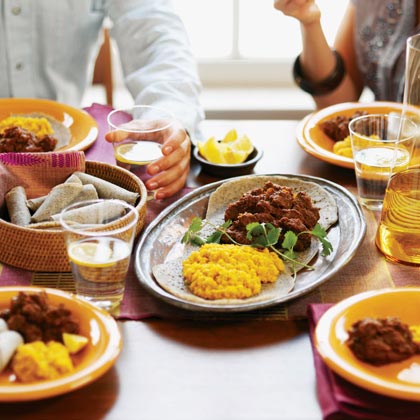Beef Stew in Spicy Berbere Sauce

How to Make It
In a food processor, pulse onions until very finely diced (almost puréed).
Melt butter in 4- to 5-quart pan over medium-high heat. Add onions and stir until browned, about 10 minutes.
Add ginger, paprika, cayenne, cumin, fenugreek, turmeric, cinnamon, cardamom, cloves, and allspice; stir until fragrant, about 1 minute. Add tomatoes, wine, and beef; bring to a simmer, then cover, reduce heat, and simmer, stirring occasionally, until beef is very tender when pierced, about 2 hours. Add salt to taste.
Note: Nutritional analysis is per serving.
Ethiopian cooking 101:
Berbere: This heady spice mixture is the basis for all Ethiopian cooking. It can feature clove, cayenne, ginger, cumin, turmeric, and cinnamon, among other spices. Ground fenugreek seeds, which add a mildly sweet flavor, are also typical. Buy them at Middle Eastern markets or from Penzeys Spices ($09 per 1/4-cup jar; www.penzeys.com).
Injera: Authentic injera is made from fermented teff, a grain common in Ethiopia. The bread's spongy, bubbly texture is similar to that of a pancake. If authenticity is your aim, you can buy teff flour from Abyssinian Market ($25 for 5 lb.; www.abyssinianmarket.com).
Tej: This Ethiopian honey wine is the traditional match for spicy stews, but few retailers in the United States carry authentic imported tej. You can buy a bottle at many Ethiopian restaurants, but an accessible alternative is off-dry Riesling, which pairs beautifully with the spicy beef stew. Our favorite: Spätlese Rieslings from Germany's Mosel region.
Ingredients
Directions
In a food processor, pulse onions until very finely diced (almost puréed).
Melt butter in 4- to 5-quart pan over medium-high heat. Add onions and stir until browned, about 10 minutes.
Add ginger, paprika, cayenne, cumin, fenugreek, turmeric, cinnamon, cardamom, cloves, and allspice; stir until fragrant, about 1 minute. Add tomatoes, wine, and beef; bring to a simmer, then cover, reduce heat, and simmer, stirring occasionally, until beef is very tender when pierced, about 2 hours. Add salt to taste.
Note: Nutritional analysis is per serving.
Ethiopian cooking 101:
Berbere: This heady spice mixture is the basis for all Ethiopian cooking. It can feature clove, cayenne, ginger, cumin, turmeric, and cinnamon, among other spices. Ground fenugreek seeds, which add a mildly sweet flavor, are also typical. Buy them at Middle Eastern markets or from Penzeys Spices ($09 per 1/4-cup jar; www.penzeys.com).
Injera: Authentic injera is made from fermented teff, a grain common in Ethiopia. The bread's spongy, bubbly texture is similar to that of a pancake. If authenticity is your aim, you can buy teff flour from Abyssinian Market ($25 for 5 lb.; www.abyssinianmarket.com).
Tej: This Ethiopian honey wine is the traditional match for spicy stews, but few retailers in the United States carry authentic imported tej. You can buy a bottle at many Ethiopian restaurants, but an accessible alternative is off-dry Riesling, which pairs beautifully with the spicy beef stew. Our favorite: Spätlese Rieslings from Germany's Mosel region.

